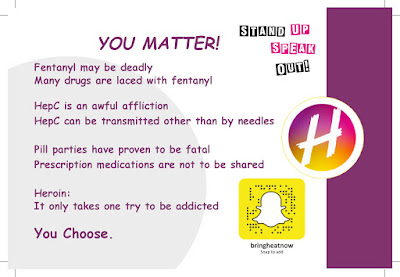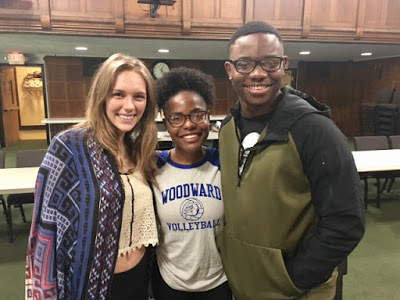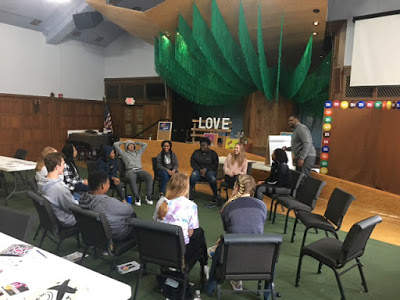It turned out, after Student Ambassadors starting spreading the HEAT messages online and at their schools, they wanted to get to know each other in person. “We were hearing from the students directly that they wanted more face time with each other,” explained Robinson, HEAT’s Program Director. So the Teen Leadership Summits were born.
Since December 2018, groups of 15-25 Ambassadors have met at Hyde Park Community United Methodist Church one Saturday morning a month to empower one another to become better equipped to combat drug abuse, bullying, isolation and depression in their schools.
So far, topics have included:
– What their schools are doing well and could do better
– What they, as individuals, can commit to doing to make a difference
– Living in balance; having activities of passion to balance out ones that aren’t as exciting (like school)
– How to stand up when you see something that isn’t right
– Handling stress
– Time management
– The pressures of being perfect students and keeping up with older siblings’ accomplishments
– Juggling jobs and school
– Shattering the stigma of social cliques
– Bullying
– Crossing social divides
– Creating socially safe environments
Diverse group, unique meeting format
HEAT’s Student Ambassadors get practice making friends with people different from them just by coming to the summits. A wide range of schools participate, including:
– Boys Hope Girls Hope (representing several schools)
– Cincinnati Country Day
– Dohn Community
– Goshen
– Mercy McAuley
– Norwood
– Roger Bacon
– Seven Hills
– St. Ursula Academy
– St. Xavier
– Ursuline Academy
– Villa Madonna
– Withrow
– Woodward
-DePaul Cristo Rey
While the students represent a diversity of races and socio-economic groups, they find common ground on many issues. And, they can all earn Community Service hours for participating in the summits.
“They like having an off-site place to meet and the chance to be with peers who did not know them before,” notes Robinson. “A HEAT Club at school would pigeonhole them, since they feel pre-labeled with their social group affiliation. Here they can just be themselves.”
“Every month we have at least one new school participating, and many students return time after time. The invitation is open always; any student can come, and there is no limit to the number of students per school allowed to participate. You don’t have to be a registered Student Ambassador to attend. The summits can be a point of entry to HEAT.”
The 1.5-hour summit format is unique.
After a short social time with donuts and orange juice, the day’s topic is introduced by the adult leaders: Robinson; HEAT Executive Director Bob Buechner; President Dick Adams; Greg Ross, athletic director at Cincinnati Country Day; Alpacino Beauchamp, Principal of Roberts Academy; and sometimes a guest. Then, the students go off on their own, break up into smaller groups (or not), and discuss the questions presented by the adults.
After a half hour, the students return to share their takeaways with each other and the adults. Together, the group brainstorms how to take the ideas discussed back to their own schools.
The focus for several meetings in the spring was social safety, Robinson says, because bullying contributes to poor academic performance, depression, anxiety and suicide. “This is more than the stereotypical bullying image of a lunch box being knocked out of a child’s hands on the playground. It’s where you sit at lunch, being ousted from a clique, being torn between two groups.”
“I really like the strategies the students came up with. One tip, for reaching across social lines to someone it would be ‘taboo’ to socialize with, was to find a point of commonality. They decided they would try paying attention to what is going on with a ‘loner’ in terms of sports or the arts. For example, a jock could ask a theatre person, ‘How did your play go last weekend?’.”
The bottom line? Mental health
Robinson says what the students really want is more mental health support at school. “They unanimously have expressed wanting more mental health training for teachers. The student next to them might be in distress. Students don’t trust that the teachers know how to recognize the red flags and know what to do about them.”
“It isn’t just school shootings; it’s psychological safety. The students feel a burden of the rise in suicides and depression. If they sense the kid next to them is suffering, whether or not that person is a friend, they feel powerless to do anything, and want an adult to intervene; on the spot, not just by referring the student to the school counselor’s office later in the day or week.”
“When a student has a problem it goes through the whole day; it doesn’t wait for the counselor appointment. It affects everyone around that student. We are hearing that students want the teachers to have their eyes on the kids, to recognize who is in trouble, and have tools to help.”
Why are today’s youth so sensitive?
While she thinks some of the struggles of today’s youth may be related to the Digital Age, Robinson also believes there is a new energetic sensitivity in today’s students. “They seem to have a higher, more developed sense of emotional intelligence than previous generations,” she notes.
”It is harder than ever for young people to be in this world. Through social media, they see and hear things they might have been sheltered from in times past. They have incredible empathy and thinner filters. Social media both connects and isolates. Bullying and brutality have gone online, and it is hard to escape a relentless feeling of being judged.”
Taking the message to legislators
After each summit, the adults carry the student feedback forward to alliance groups such as Talbert House, Boys Hope Girls Hope, Stopping the Abuse Before it Starts, Wall2Wall, Drug-Free Clubs of America, Cincinnati Bar Foundation, Western Southern, WeThrive, Warren County Teen Alliance Council, Northern Kentucky Regional Youth Leadership and Hamilton County Heroin Coalition.
But if more funds are going to become available for mental health training for teachers, politicians are going to have to push for them, Robinson says. Toward that end, HEAT students will attend several meetings with State of Ohio leaders this summer, including the prevention director of Ohio Mental Health and Addiction Services, Governor DeWine’s Recovery Ohio leaders and the director of Children’s Initiatives. Several students will also travel to Columbus to meet with cabinet level directors.
 |
| Message on back of HEAT card |
As it becomes better known, Robinson wants to see HEAT continue to reach more students and grow beyond Cincinnati. “I would like to see our model re-created across the country.”
Plans are afoot to reach over 45,000 youth soccer players with HEAT cards through the national communication network of Wall2WallSoccer. A school-day leadership forum for 8th-graders in Cincinnati Public Schools is also planned, along with an expansion of HEAT’s social media alerts and VibeApp pop-up notifications.
HEAT is collaborating with CareSource and the Ohio Attorney General’s office to develop a proven metric system to ensure their approach is as effective as possible.
You can learn more about HEAT on Instagram: @heat_empowering_teens; Snapchat: @bringheatnow; on their website: www.BringHEAT.org; or on YouTube.
To contact Robinson directly, email bringheat513@gmail.com.

